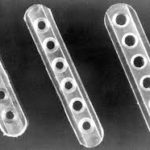Contemporary rhinoplasty employs three fundamental concepts, open exposure, cartilage preservation, and structural support. The latter, partially influenced by the second principle of cartilage saving, often involves the introduction of cartilage grafts in key support locations such as the columella, septum, middle vault, and the lower alar cartilages. This ideally creates a need for straight cartilage pieces and skill in harvesting cartilage in general from several different locations.
An alternative or adjunctive method for adding cartilage support is to use synthetically manufactured materials with or without cartilage components. A thin synthetic sheet or mesh could be cut into any straight shape of any length and provides as much support as any piece of cartilage. The use of this concept could simplify and shorten some rhinoplasty procedures and save the need for donor sites in others. It could also be a savior in cases where the patient is cartilage-depleted and rib grafts are the only option.


One question to ask about this supplement to cartilage grafting (or cartilage graft replacement in some cases) is…what happens when the material weakens and eventually goes away. As a cartilage supplement, the cartilage should have healed enough so that the loss of the resorbable support does not matter. When used as a cartilage replacement, however, the outcome is not as clear. I suspect that it is influenced by how much material is used and how critical it was to the support area. As the material is absorbed, it will be replaced by some scar. Whether the residual scar can serve the same role as the resorbable construct is not yet known.
Dr. Barry Eppley
Indianapolis, Indiana


